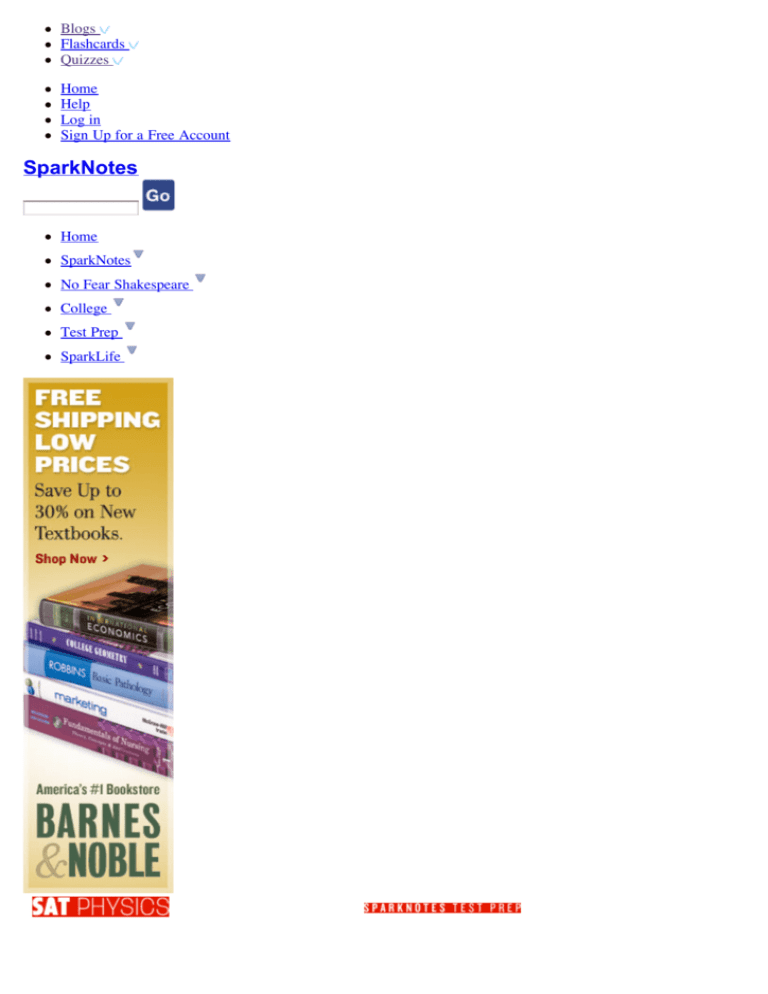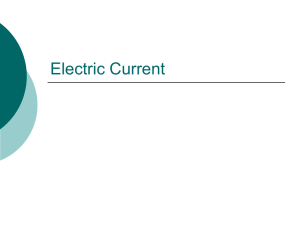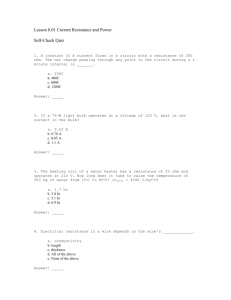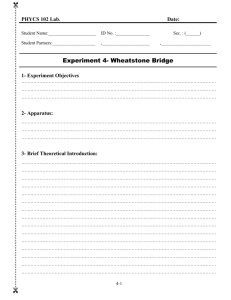
Blogs
Flashcards
Quizzes
Home
Help
Log in
Sign Up for a Free Account
SparkNotes
Home
SparkNotes
No Fear Shakespeare
College
Test Prep
SparkLife
DC Circuits
<< RETURN TO THE PREVIOUS SECTION | CONTINUE TO THE NEXT SECTION >>
14.1
VOLTAGE
14.6
CAPACITORS
14.2
CURRENT
14.7
KEY FORMULAS
14.3
RESISTANCE
14.8
PRACTICE QUESTIONS
14.4
ENERGY, POWER, AND HEAT
14.9
EXPLANATIONS
14.5
CIRCUITS
Resistance
Some materials conduct current better than others. If we had a copper wire and a
glass wire with the same length and cross section, and put the same potential
difference across them, the current in the copper wire would be much larger than the
current in the glass wire. The structure of copper, a conductor, is such that it permits
electrons to move about more freely than glass, an insulator. We say that the glass
wire has a higher resistance, R , than the copper wire.
We can express resistance in terms of the potential difference,
, and the current, I:
Generally, the is omitted. For a given voltage, the larger the current, the smaller
the resistance. The unit of resistance is the ohm ( ). One ohm is equal to one volt
per ampere: 1 = 1 V/A.
Ohm’s Law
Ohm’s Law relates the three important quantities of current, voltage, and resistance:
This equation tells us that we can maximize the current by having a large voltage drop
and a small resistance. This is one of the most important equations dealing with
electromagnetism, and SAT II Physics is bound to call upon you to remember it.
EXAMPLE
Three batteries are added to a circuit, multiplying the potential difference in the circuit by four.
A resistor is also added, doubling the resistance of the circuit. How is the current in the wire
affected?
Taking the initial voltage to be V and the initial resistance to be R , the initial current is
= V/R. The new voltage is 4V and the new resistance is 2R , so the final current is:
These changes double the current.
Resistivity
Resistivity,
, is a property of a material that affects its resistance. The higher the
resistivity, the higher the resistance. Resistance also depends on the dimensions of
the wire—on its length, L, and cross-sectional area, A :
A longer wire provides more resistance because the charges have farther to go. A
larger cross-sectional area reduces the resistance because it is easier for the charges
to move. The unit of resistivity is the ohm-meter, · m. The resistivity of copper is
about 10–8
· m and the resistivity of glass is about 1012
temperatures, the resistivity of most metals increases.
· m. At higher
EXAMPLE
A copper wire of length 4 m and cross-sectional area 4 mm2 is connected to a battery with a
potential difference of 9 V. What is the current that runs through the wire? Approximate the
resistivity for copper to be 10–8
· m.
As we know, the current in a wire is a measure of voltage divided by resistance. We
know that the voltage for the circuit is 9 V, but we don’t know the resistance.
However, since we know that the resistivity for copper is 10–8
· m, we can use the
formula for resistivity to calculate the resistance in the wire.
First, we need to remember that area is measured in m 2, not mm2. If 1 mm =
m, then 4 mm2 =
=
m 2.
Now we can plug the values for the resistivity of copper and the length and crosssectional area of the wire into the equation for resistivity:
Once we know the resistance of the circuit, calculating the current involves a simple
application of Ohm’s Law:
Conductivity
Infrequently, you may come across talk of conductivity and conductance rather
than resistivity and resistance. As the names suggest, these are just the inverse of
their resistant counterparts. Saying a material has high conductivity is another way
of saying that material has a low resistivity. Similarly, a circuit with high conductance
has low resistance. Someone with half a sense of humor named the unit of
conductance the mho ( ), where 1 = 1
.
<< RETURN TO THE PREVIOUS SECTION | CONTINUE TO THE NEXT SECTION >>
Help | Feedback | Make a request | Report an error | Send to a friend
DC Circuits
MESSAGE BOARDS
SAT Physics Test Prep
TEST PREP CENTERS
SAT Physics Test Center
SPARKCOLLEGE
Find a School
College Admissions
Financial Aid
College Life
Contact Us | Privacy Policy | Terms and Conditions | About | Sitemap
Fiction Books | Textbooks | Classic Books | Used Books | Teen Books
©2009 SparkNotes LLC, All Rights Reserved











